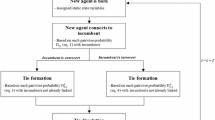Abstract
This paper examines spatial models of secession-proofness and equilibrium size which have been developed in the literature on secession. The goal of the paper is to assess whether these models are sufficiently sensitive to the dynamics of secession. Do these models sufficiently allow for a difference between ex ante and ex post incentives and choices which might be strategically exploited by actors? Are these models sensitive to the endogenous dynamics of relations between state agents and secessionists?
Similar content being viewed by others
References
Alesina A., Spolaore E.: The Size of Nations. MIT Press, Cambridge (2005)
Anderson B.: The Spectre of Comparisons: Nationalism, Southeast Asia and the World. Verso, New York (1998)
Bolton P., Roland G.: The break-up of nations: a political economy analysis. Q. J. Econ. 112, 1057–1080 (1997)
Bolton P., Roland G., Spolaore E.: Economic theories of the break-up and integration of nations. Eur. Econ. Rev. 40, 697–705 (1996)
Brancati D.: Decentralization: fueling the fire or dampening the flames of ethnic conflict and secessionism. Int. Org. 60, 651–685 (2006)
Cohen R.: Introduction. In: Cohen, R., Service, E.R. (eds) Origins of the State, Institute for the Study of Human Issues, Philadelphia (1978)
Downs A.: An Economic Theory of Democracy. Harper and Row, New York (1957)
Dreze, J., Le Breton, M., Weber, S.: Secession-Proofness in Large Heterogeneous Societies. IDEI Working Papers 410 (2006)
Fearon J.: Commitment problems and the spread of ethnic conflict. In: Lake, D., Rothchild, D. (eds) The International Spread of Ethnic Conflict, Princeton University Press, Princeton (1998)
Greenspan P.: Emotional strategies and rationality. Ethics 110, 469–487 (1994)
Haimanko O., LeBreton M., Weber S.: The stability threshold and two facets of polarization. Econ. Theory 30, 415–430 (2007)
Haimanko O., Le Breton M., Weber S.: Transfers in a polarized country: bridging the gap between efficiency and stability. J. Public Econ. 89, 1277–1303 (2005)
Hinich M.J., Munger M.C.: Analytical Politics. Cambridge University Press, Cambridge (1997)
Hotelling H.: Stability in competition. Econ. J. 39, 41–57 (1929)
LeBreton M., Weber S.: The art of making everybody happy: how to prevent a secession. IMF Staff Papers 50, 403–435 (2003)
Panizza U.: Decentralization as a mechanism to prevent secession. Econ. Notes 27, 263–279 (1998)
Schelling T.C.: The Strategy of Conflict Cambridge. Harvard University Press, Cambridge (1960)
Schelling T.C.: Strategies of commitment. In: Schelling, T. C. (ed.) Strategies of Commitment, Harvard University Press, Cambridge (2006)
Sheffer G.: Diaspora Politics: At Home Abroad. Cambridge University Press, New York (2003)
Wittman D.: The size and wealth of nations. J. Confl. Resol. 44, 868–884 (2000)
Author information
Authors and Affiliations
Corresponding author
Rights and permissions
About this article
Cite this article
Meadwell, H. Spatial models of secession-proofness and equilibrium size. Qual Quant 45, 641–652 (2011). https://doi.org/10.1007/s11135-010-9372-2
Published:
Issue Date:
DOI: https://doi.org/10.1007/s11135-010-9372-2




